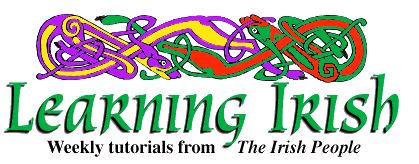
Irish Lesson 28
|
PRONUNCIATION GUIDE The letter "n" has two basic sounds. The broad sound, made with the tongue spread soemwhat and pressed against the upper front teeth, occurs when the "n" begins a word and the next vowel is "a, o, u". Examples: ná, nó, nús, nasc (nahsk), náisiún (naw*-SHOON), nocht (nohk*t). The slender sound of "n" occurs when "n" starts a word in which the first vowel is "e, i". The "n' is pronounced with the front of the tongue on the hard rim behind the upper front teeth. There will be a faint sound resembling "yuh" at the end as you begin to pronounce the rest of the word. Do not pronounce a separate (yuh) sound, however. Examples: néid (nyay*d), ní (nee), níl (neel), nead (nyad), neimh (nyev), neoin (NYOH-in). Notice that in "ní" and "níl", the (yuh) sound trace disappears. If "n" is inside a word or at the end, the pronunciation is usually similar to the American pronunciation of "n". Compare "ainm" (AN-im) with "anam" (AH-nuhm). See Lesson 25 for the difference in "m" pronunciation. The "m" is slender in "ainm" and broad in "anam", but the "n" in both words resembles the "n" you know from English. Slender double "n" at a word end after "e, i" can be pronounced either (n) or have a faint (y) sound at the end. The sound may resemble the (ng) sound at the end of English "sing". Try: sinn (shin); linn (lin), crainn (krin). Pronounce double "n" broad like a broad "n" that starts a word, such as "ná". Try: tagann (TAHG-uhn), donn (doun). A slender double "n" inside a word gets a clear (y) sound, as in bainne (BAHN-ye), rinne (RIN-ye), fuinneog (fwin-YOHG). A broad "n" sound can begin a word in which the next vowel sound is slender, (ay*) or (ee). "Naoi" and "naíonán" are examples. A faint, short (uh) sound occurs between the (n) and (ee). Try: naoi (nee), naíonán (NEE-uh-naw*n). This "n" differs from the slender "n" in "ní" or "Nioclás" (NEE-klaw*s). GRAMMAR Although the ending "-amar" or "eamar" is common for indicating "we" in the past tense of verbs, the seperate word "muid" (mwid) is used, too. For example: bhuail muid (VWOO-il mwid), we struck; thuig muid (HIG mwid), we understood; cheannaigh muid (HYAN-ee mwid), we bought. Both ways are acceptable. Most moden grammars give the "-mar" ending for their examples, but you should be familiar with the two forms. VOCABULARY fág, ag fágáil (faw*g, uh FAW*G-aw*-il) leave. Also in: fág fúmsa é (faw*g FOOM-suh ay*), Leave it to me. deisigh, ag deisiú (DESH-ee, uh DESH-yoo) repair, "fix" tóg, ag tógáil (tohg, uh TOHG-aw*-il), take, raise crith, ag crith (kri), shake mag, ag magadh (mahg, uh MAHG-uh) mock, "slag" As in: ag magadh fúm (foom), making fun of me. síl, ag síleadh (sheel, uh SHEEL-uh), think troid, ag troid (trid, uh trid) fight léim, ag léim (lay*m, uh lay*m) jump REFLEX EXPRESSIONS le tamall (le TAH-muhl), for a while is fíor sin (is FEE-uhr shin), That's true le fada (le FAH-duh), for a long time saor go leor (SAY*-uhr goh LOHR), cheap enough áit éigin (aw*t AY*-gin) some place DRILL We will first review the use of "is" (is). Repeat this sentence group: Céard é seo? (kay*rd) Céard é sin? Is leabhar é. Is sráid é. Ní scoil é. An bosca é? (BOHSK-uh) Ní hea, ach buidéal (nee ha, ahk* bwi- DAY*L). An bord é seo? Is ea. Now substitute into the sentences Irish words for objects you know. Go through the entire sequence for each word. Next, repeat this sentence group: Cé hé seo? (kay* hay* shuh) Cé hí seo? Cé hé sin? Cé hí sin? Is é Seán é (shay* shaw*n ay*). Ní hí Nóra í. Is é Seán an fear (far). Is í Máire an dochtúir (dohk*-TOO-ir). Is é sin Brian (shay* shin BREE-uhn). Is í seo Cáit (kaw*t). Is é seo Liam. Is í sin Bríd (shee shin breed). Now substitute into the sentences Irish names that you know from the conversations, and also nouns with "the" before them, such as: the room, the road, the place, the table, the girl, the car, etc. Then try to add sentences in the past tense to: Is é Seán an fear a --. Example: Is é Seán an fear a cheannaigh an carr nua. Try verbs such as: caith, cuir, rith, scríobh, etc. PRACTICE READING A translation follows this: Tá Liam sa bhaile. Ní raibh sé amuigh inné. Bhí sé ag scríobh litreach. Bhíomar ag féachaint air (FAY*-uhk*-int er). Chuir sé an litir sa phost agus ansin d'ith sé a shuipéar (hu-PAY*R). Thógamar ár mbróga (MROHG-uh) chuig (hig) an gcathair (GAH-hir), agus dheisigh an fear sin iad. D'imíomar linn abhaile ansin. Ag baile, bhí an cat agus an madra ag troid. Throid siad cúpla nóiméad, agus ansin chaitheamar amach iad. [William is at home. He wasn't out yesterday. He was writing a letter. We were watching him. He put the letter in the post and then he ate his supper. We took our shoes to the city, and that man repaired them. We departed (departed with ourselves) homeward then. At home, the cat and the dog were fighting. They fought for a couple of minutes, and then we threw them out.] (Note: Both "abhaile" (uh-VWAHL-e) and "ag baile" (eg BAHL-e) mean "at home.") (c) 1997 The Irish People. May be reprinted with credit. |